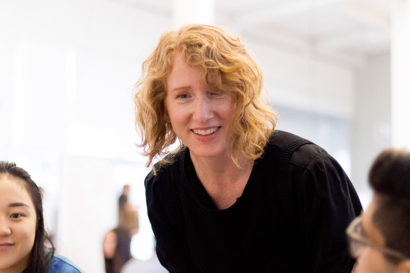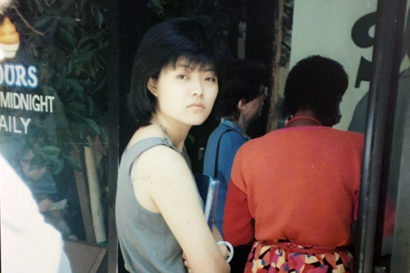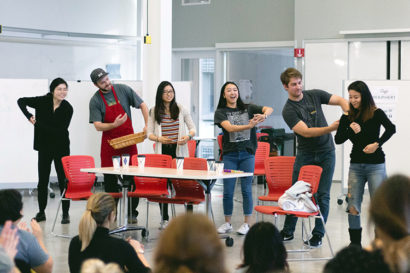Dance and art, meet business: You’re more alike than you think
Collaborative Innovation, a Big Ideas course, teaches students techniques for group creativity and team-based design
March 14, 2018
When Kelly Chou, a freshman chemistry major, started at UC Berkeley last semester, she felt overwhelmed. She was taking all STEM classes and she was missing an outlet for her risk-taking, creative side.
After participating in a design-a-thon in Jacobs Hall, she realized she needed a course where she could break out of the rigid structure of her undergraduate chemistry courses. So she enrolled in Collaborative Innovation, a Big Ideas course in the College of Letters and Science, and found just what she was looking for.

Collaborative Innovation, a Big Ideas course, teaches students how to work creatively in teams. (Photo by Lana Cosic)
“I just love that feeling of high-energy collaboration,” Chou says, “when we’re all kind of in the thick of it and it’s just bubbling with creative energy. It’s an electrifying feeling.”
The course, open to undergraduates from all disciplines, is designed to get people working together to create projects that embody a range of ideas and ways of thinking. It’s broken up into four sections, each taught by a different professor or lecturer of theater, dance and performance, art practice and business, who share specific techniques for group creativity and team-based design.
Choreographer Lisa Wymore, associate professor and chair of the Department of Theater, Dance and Performance Studies, teaches the dance and performance section of the course, which focuses on group storytelling. Collaboration, she says, is essential to dance — and the same skills can be applied to other fields of study and professions.

Lisa Wymore, chair of theater, dance and performance studies, teaches a section of Collaborative Innovation. (Photo by Lana Cosic)
“In dance, you have to work on trust,” she says. “You have to learn when to step forward and when to step back. You need to know when you contribute and when to listen.”
This semester, Wymore asked her students to bring in an object that spoke to where they come from. Chou brought in a photo of her mother standing in front of Yogurt Park, a popular frozen yogurt shop near campus, when she was a student at Berkeley 30 years ago.
“I had been looking at this picture for my entire life, but I had no concept of where this place was,” says Chou.

Kelly Chou’s mom standing in line at Yogurt Park as a Berkeley student 30 years ago. (Photo courtesy of Kelly Chou)
Although she and her mom had very different upbringings — her mom came to California from Taiwan as a teenager, not speaking any English — being on campus today has allowed Chou to close the distance between their two worlds.
“She grew up in a very different set of circumstances than I did and because of that, I felt like I was never able to connect with her in any way. Now, I’m here and I can kind of have the same experience she had.”
In the class, Chou was teamed up with a group of students with whom she had never worked, and together they were asked to create a performance that embodied a common theme they found among their personal stories. They came up with “connection.”
During the collaboration process, Chou noticed that people communicated in different ways, depending on their interests and areas of expertise — a data science major would often talk about how to incorporate technology into their project; a performance major would discuss the tactile feeling of emotion and its connection to movement.
As a chemistry major, Chou says she thinks a lot about the synthesis of ideas. “I’m really interested in putting two different things together to make a new thing,” she says. “Like, sodium and chloride. Separately, they’re both toxic, but together they make salt. So, the components are often completely different than the product, and I think I really take that to heart when I think about collaboration.”
The group’s final performance was a short play about strangers meeting each other in a coffee shop, each finding an unexpected connection to another.
Collaboration can be messy and frustrating, says Wymore, but the process can help students step outside of their daily routines and patterns of thinking and really get to know and trust one another in a deeper way.

Chou (left) and her team perform their final project about strangers making unexpected connections in a coffee shop. (Photo by Lana Cosic)
“The main thing we want to teach is really to have an open mindset towards willingness to see things from multiple perspectives,” she says. “There’s a deep level of empathy in this class. There’s a lot of learning on those teams. They learn that their ideas matter, that they have a voice to be heard. It’s not a plunk-down-and-listen class; it’s a doing-with-others class.”
Chou plans to pursue a career in cosmetic chemistry, working with a small startup team, and says she thinks her new skills could help her collaborate with her teammates to help build a successful company.
Other sections of the four-credit course are taught by Sara Beckman, founder of the class and a senior lecturer at Haas School of Business; Sean San José, a lecturer in the Department of Theater, Dance and Performance Studies; and Takming Chuang, a visiting lecturer in the Department of Art Practice.
Learn more about the Big Ideas course, Collaborative Innovation, on the College of Letters and Science website.
